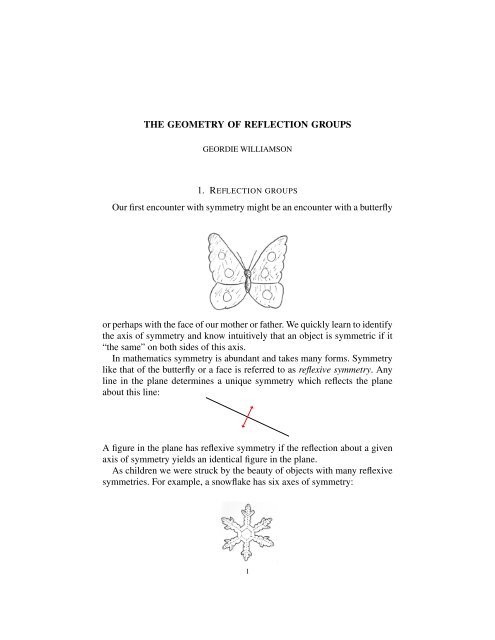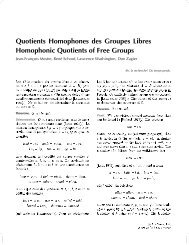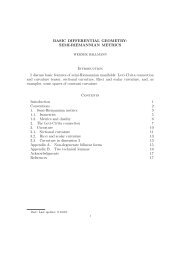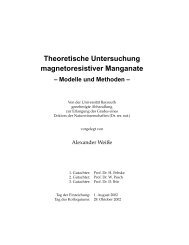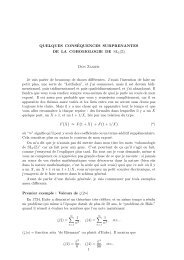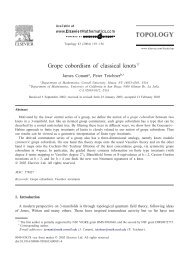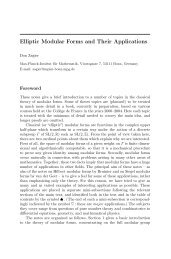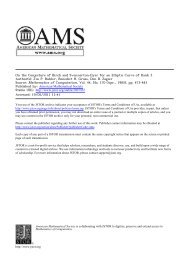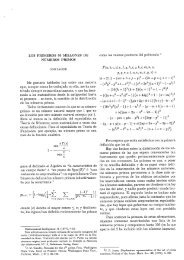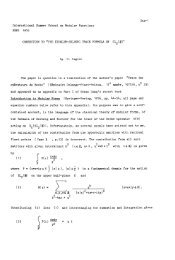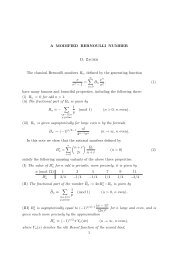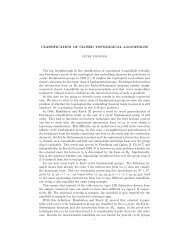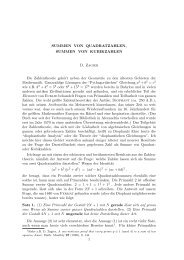THE GEOMETRY OF REFLECTION GROUPS Our first encounter ...
THE GEOMETRY OF REFLECTION GROUPS Our first encounter ...
THE GEOMETRY OF REFLECTION GROUPS Our first encounter ...
Create successful ePaper yourself
Turn your PDF publications into a flip-book with our unique Google optimized e-Paper software.
<strong>THE</strong> <strong>GEOMETRY</strong> <strong>OF</strong> <strong>REFLECTION</strong> <strong>GROUPS</strong>GEORDIE WILLIAMSON1. <strong>REFLECTION</strong> <strong>GROUPS</strong><strong>Our</strong> <strong>first</strong> <strong>encounter</strong> with symmetry might be an <strong>encounter</strong> with a butterflyor perhaps with the face of our mother or father. We quickly learn to identifythe axis of symmetry and know intuitively that an object is symmetric if it“the same” on both sides of this axis.In mathematics symmetry is abundant and takes many forms. Symmetrylike that of the butterfly or a face is referred to as reflexive symmetry. Anyline in the plane determines a unique symmetry which reflects the planeabout this line:A figure in the plane has reflexive symmetry if the reflection about a givenaxis of symmetry yields an identical figure in the plane.As children we were struck by the beauty of objects with many reflexivesymmetries. For example, a snowflake has six axes of symmetry:1
2 GEORDIE WILLIAMSONAn infinite beehive has infinitely many symmetries:· · · · · ·A fascinating area of current mathematical study is that of reflectiongroups. These are collections, or groups, of symmetries in which everysymmetry can be expressed as compositions of reflexive symmetries. Thesymmetry group of a butterfly is the set {id, s} where s is the reflexive symmetry.We write ss = s 2 = id to express the fact that if we perform s twicewe “do nothing”, referred to as the identity transformation in the theory ofgroups.The next simplest example of a reflection group is the symmetries of anequilateral triangle:The reflections in the marked axes of symmetries give three reflexive symmetries.The reader can check that performing two reflections in two differentaxes of symmetry yields a rotation. This gives a complete descriptionof the group of symmetries of the triangle: it has three reflexive symmetries,two rotational symmetries and the identity transformation.Similarly, the symmetries of a regular polygon with n facesn = 7yields a group with n reflections, n − 1 rotations and the identity transformation,giving a total of 2n symmetries. If n = 6 we recover the symmetriesof the snowflake!The notion of reflexive symmetry makes sense in any dimension. In onedimension the “axis of symmetry” is a point:•
3In three dimensions reflections take place about a plane:How many reflection groups are there? In one dimension there are onlytwo. The <strong>first</strong> is the symmetries of the butterfly, which is really a onedimensionalexample (perhaps the reader can see why?). The second can bedescribed as the symmetries of an infinite row of symmetrical houses:· · · · · ·Or as the symmetries of the whole numbers amongst all real numbers:• • • •Here there are infinitely many axes of symmetry. This is an example of aninfinite reflection group.In two dimensions the situation is more complicated. One might startwith the symmetries of a rectangle:However mathematicians regard this as being simply two copies of the symmetriesof the butterfly. (The horizontal and vertical symmetries do not interract.Hence the symmetry group of the rectangle is simply a “product” ofthe symmetries in the horizonal and verticle directions.)Ignoring examples that “come from one dimension” it turns out that all finitereflection groups are given by the symmetries of a regular n-gon, whichwe discussed above. There are infinite examples of two types. The <strong>first</strong> type
4 GEORDIE WILLIAMSONconsists of the symmetries of crystal structures in the plane:(The last example is the infinite beehive.)The second class of infinite reflection groups consists of symmetries ofthe hyperbolic plane, an example of a non-euclidean geometry. In schoolwe learn that sum of the angles of a triangle is always equal to π. Howeverthis is only true in the plane. On the surface of a sphere the angle sum ofa triangle lies between π and 3π, depending on how big the triangle is. Inthe hyperbolic plane all triangles have angle sums between 0 (big triangles)and π (small triangles).It turns out that for any positive integers p, q, r ≥ 2 such that1p + 1 q + 1 r < 1there exists a two dimensional reflection group, acting as symmetries on thehyperbolic plane. For example, the symmetries of the following configurationin the hyperbolic planecorresponds to p = 2, r = 3 and q = 7. Because almost all triples (p, q, r)of positive integers satisfy the above inequality, almost all two dimensionalreflection groups are hyperbolic.
In three dimensions there are many infinite reflection groups. However,it turns out that the only finite reflection groups are those that “come fromdimension 2” together with the symmetries of the platonic solids:5The reader might remember that the cube and octahedron as well as the icosahedronand dodecahedron are “dual”, and hence their symmetry groupsare equal.2. CONTINUOUS AND DISCRETE SYMMETRYReflection groups are discrete: one cannot move a symmetry a smallamount and obtain a new symmetry. For example in any of the examplesabove, moving an axis of symmetry a small amount never results in a newaxis of symmetry.An example of a group which does not have this property is the group ofsymmetries of a circle:Here any line through the origin serves as an axis of symmetry. Similarlyany rotation about the origin is a symmetry. Here one speaks of continuoussymmetry. Other examples of continuous symmetry include the symmetriesof a sphere, or the group of all rigid motions of space.Groups of continous symmetry were <strong>first</strong> investigated in depth by a Norwegianmathematician Sophus Lie, and today are called Lie groups. Lienoticed that many equations governing the world around us have large degreesof continuous symmetry. He hoped that the presence of this symmetrycould be used to constrain solutions. This simple idea plays a fundamental
6 GEORDIE WILLIAMSONrole in modern mathematics and physics. (Fourier analysis, a basic and pervasivetool in modern science, gives one of the simplest examples of thisphenomenon.)Lie also initiated a program, which continues to this day, to understandthe structure of groups of continous symmetry. Here an amazing fact emerges:one can associated to any Lie group (usually a rather complicated highdimensionalobject) a finite reflection group! This finite reflection group iscalled Weyl group after the German mathematician Hermann Weyl whoemphasised its importance in understanding the structure of Lie groups.The way in which one associates the Weyl group to a Lie group is asomewhat tricky process, and we will have to be content with discussingthe <strong>first</strong> interesting example. If we consider the Lie gorup of symmetries ofthe sphere, then its Weyl group is the symmetries of the butterfly!(For the interested reader, one obtains the Weyl group in this exampleas follows: <strong>first</strong>, fix a line l through the origin and consider all rotations ofthe sphere which preserve this line. Such rotations are of two types: thoserotations in the axis l (which fix l pointwise), and those rotations through πin an axis perpendicular to the chosen line (which act as a reflection on theline l). The residual action of these rotations on l is the simplest exampleof a reflection group!)These ideas allowed Lie, Cartan and Killing to obtain a complete classificationof the so-called connected compact Lie groups. A startling featureof this classification is that one has a number of families in all dimensions(for example the symmetries of the spheres in all dimensions), togetherwith certain exceptional groups, which occur only in “small” dimensions.The largest of these examples if a 248 dimensional Lie group which mathematicianscall E 8 .The Weyl group of the Lie group E 8 is a fascinating, but complicated8-dimensional reflection group which is the symmetries of a certain collectionof vectors in 8 dimenionsal space. Mathematicians have drawn the
7following picture of these vectors:The group Lie group E 8 been the subject of much investigation and speculationby mathematicians and physicists alike, with some even positing it asgiving the elusive theory of everything!3. CURRENT DIRECTIONSFourier series and the Fourier transform emerges naturally when on doescalculus on the two simplest Lie groups: the groups of rotations of the circle,and the group of translations of the real line. Doing calculus on the Liegroup of rotations of the 2-sphere may be used to determine the spectrum ofthe hydrogen atom, which was the <strong>first</strong> breakthrough in quantum mechanics.Today the subject of calculus on Lie groups is an active and fascinatingsubject. In modern language one wishes to determine the unitary dual of aLie group. This remains an unsolved problem. A major breakthrough wasobtained by Kazhdan and Lusztig in 1979 who defined certain polynomialsfor every pair of elements in the Weyl group of a Lie group. Work of a numberof mathematicians has highlighted the importance of these polynomialsin many situations where discrete or continuous symmetry is present. In particular,this led to a major breakthrough (though not a complete solution) tothe problem of determining the unitary dual.One curious feature of Kazhdan and Lusztig’s construction is the following:if one starts with a Lie group, its Weyl group is necessarily a finite
8 GEORDIE WILLIAMSONreflection group of a special type. For example the only two dimensional reflectiongroups which occur are the symmetries of the triangle, square andhexagon. Similarly, in dimension three the symmetry group of the a tetrahedronand cube occurs, whereas the symmetry group of the icosahedrondoes not. However Kazhdan and Lusztig’s constructure still makes sense,and produces polynomials with remarkable properties. Only time will tellwhat these polynomials are trying to tell us!MAX-PLANCK-INSTITUT FÜR MA<strong>THE</strong>MATIK, VIVATSGASSE 7, 53111 BONN, GER-MANYE-mail address: geordie@mpim-bonn.mpg.de


